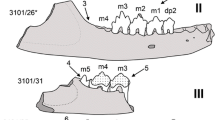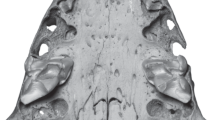Abstract—
The maxillary fragment of eutriconodontan Gobiconodon borissiaki Trofimov, 1978 (Gobiconodontidae) is described from the Early Cretaceous Zuun-Höövör locality in Mongolia (Övörkhangai aimag, Guchin-Us sum). It demonstrates erupting М2RR (second molariform tooth of the third generation) along with the presence of the almost unworn M4R and alveoli of M3R and M5. This is the first direct evidence of the molariform tooth replacement in Gobiconodon from the Early Cretaceous of Mongolia. The CT study of the specimen revealed the absence of mineralized germs of other teeth.


Similar content being viewed by others
REFERENCES
Lopatin, A.V. and Averianov, A.O., Gobiconodon (Mammalia) from the Early Cretaceous of Mongolia and revision of Gobiconodontidae, J. Mamm. Evol., 2015, vol. 22, no. 1, pp. 17–43.
Kusuhashi, N., Wang, Y.-Q., Li, C.-K., and Jin, X., Two new species of Gobiconodon (Mammalia, Eutriconodonta, Gobiconodontidae) from the Lower Cretaceous Shahai and Fuxin formations, northeastern China, Hist. Biol., 2016, vol. 28, nos. 1–2, pp. 14–26.
Kusuhashi, N., Wang, Y.-Q., Li, C.-K., and Jin, X., New gobiconodontid (Eutriconodonta, Mammalia) from the Lower Cretaceous Shahai and Fuxin formations, Liaoning, China, Vertebr. PalAsiat., 2020, vol. 58, no. 1, pp. 45–66.
Jenkins, F.A. and Schaff, C.R., The Early Cretaceous mammal Gobiconodon (Mammalia, Triconodonta) from the Cloverly Formation in Montana, J. Vertebr. Paleontol., 1988, vol. 8, no. 1, pp. 1–24.
Kielan-Jaworowska, Z. and Dashzeveg, D., Early Cretaceous amphilestid (“triconodont”) mammals from Mongolia, Acta Palaeontologica Polonica, 1998, vol. 43, no. 3, pp. 413–438.
Martin, T., Marugán-Lobón, J., Vullo, R., et al., A Cretaceous eutriconodont and integument evolution in early mammals, Nature, 2015, vol. 526, no. 7573, pp. 380–384.
Trofimov, B.A., The first triconodonts (Mammalia, Triconodonta) from Mongolia, Dokl. Akad. Nauk SSSR, 1978, vol. 243, no. 1, pp. 213–216.
Lopatin A.V. and Badamgarav, D., Zuun-Höovör, Övörkhangai, Mongolia: a new locality of Early Cretaceous mammals, Dokl. Earth Sci., 2013, vol. 453, pt. 2, pp. 1178–1180.
Lopatin, A.V., Mammalian tooth marks on the bone of eutriconodontan Gobiconodon borissiaki (Mammalia, Gobiconodontidae) from the Lower Cretaceous of Mongolia, Dokl. Earth Sci., 2021, vol. 501, suppl. 1, pp. S18–S21.
Lopatin, A.V., Early Cretaceous mammals from the Khamryn-Us and Shalan-Ikher localities in Mongolia, Dokl. Biol. Sci., 2017, vol. 477, pp. 210–213.
Smith, H.V., Evolutionary lines in tooth attachment and replacement in reptiles: their possible significance in mammalian dentition, Trans. Kans. Acad. Sci., 1958, vol. 61, no. 2, pp. 216–225.
Luo, Z.-X., Kielan-Jaworowska, Z., and Cifelli, R.L., Evolution of dental replacement in mammals, Bull. Carnegie Mus. Nat. Hist., 2004, no. 36, pp. 159–175.
Whitlock, J.A. and Richman, J.M., Biology of tooth replacement in amniotes, Int. J. Oral Sci., 2013, vol. 5, no. 2, pp. 66–70.
Malygin, V.M., Lykov, E.Yu., and Kalandadze, N.N., The similarity of anomalies in the dental system of the fox (Vulpes vulpes) with the teeth of the theriodont dvinia (Dvinia prima), Materialy Mezhdunarodnogo soveshchaniya “Teriofauna Rossii i sopredel’nykh territoriy” (Proc. Int. Meeting “Theriofauna of Russia and Adjacent Territories”), Moscow: KMK, 2011.
Averianov, A.O., Skutschas, P.P., Lopatin, A.V., et al., Early Cretaceous mammals from Bol’shoi Kemchug 3 locality in West Siberia, Russia, Russ. J. Theriol., 2005, vol. 4, no. 1, pp. 1–12.
Crompton, A.W. and Luo, Z.-X., Relationships of the Liassic mammals Sinoconodon, Morganucodon oehleri, and Dinnetherium, in Mammal Phylogeny: Mesozoic Differentiation, Multituberculates, Monotremes, Early Therians, and Marsupials, Szalay, F.S., Novacek, M.J., and McKenna, M.C., Eds., New York: Springer, 1993.
Gow, C.E., A new skull of Megazostrodon (Mammalia, Triconodonta) from the Elliot Formation (Lower Jurassic) of southern Africa, Palaeontologia Africana, 1986, vol. 26, no. 2, pp. 13–23.
Lopatin, A.V., Maschenko, E.N., and Averianov, A.O., A new genus of triconodont mammals from the Early Cretaceous of Western Siberia, Dokl. Biol. Sci., 2010, vol. 433, pp. 282–285.
Lopatin, A.V., Averianov, A.O., Maschenko, E.N., and Leshchinskiy, S.V., Early Cretaceous mammals of Western Siberia: 3. Zhangheotheriidae, Paleontol. J., 2010, vol. 44, pp. 573–583.
ACKNOWLEDGMENTS
The author thanks JRMPE members K.K. Tarasenko, K.Yu. Eskov, A.A. Lozovsky, S.A. Kharitonov (PIN), B. Bayarmaa, and S. Baasankhuu (Institute of Paleonto-logy, Mongolian Academy of Sciences) for participating in the collection of material at Zuun-Höövör in 2019, and S.V. Bagirov and R.A. Rakitov (PIN) for their help in preparing the illustrations.
Funding
This study was supported by a grant in the field of science in the form of subsidies from the federal budget to ensure the conduct of scientific research by Russian scientific organizations and/or educational institutions of higher education together with organizations of the CIS countries and Mongolia, as part of the implementation of the program of bilateral and multilateral scientific and technological cooperation (state contract no. 13.2251.21.0029, project “Higher Vertebrates of the Late Mesozoic and Cenozoic of Mongolia”).
Author information
Authors and Affiliations
Corresponding author
Additional information
Translated by D. Ponomarenko
Rights and permissions
About this article
Cite this article
Lopatin, A.V. DIRECT EVIDENCE OF THE MOLARIFORM TOOTH REPLACEMENT IN Gobiconodon borissiaki (GOBICONODONTIDAE, MAMMALIA) FROM THE EARLY CRETACEOUS OF MONGOLIA. Dokl Biol Sci 504, 73–77 (2022). https://doi.org/10.1134/S0012496622030012
Received:
Revised:
Accepted:
Published:
Issue Date:
DOI: https://doi.org/10.1134/S0012496622030012




